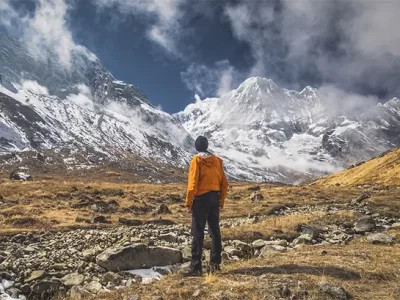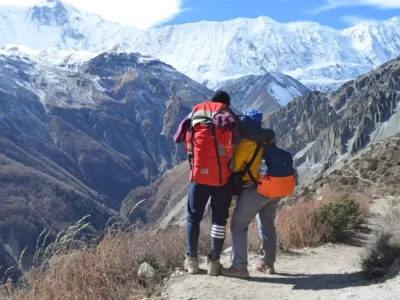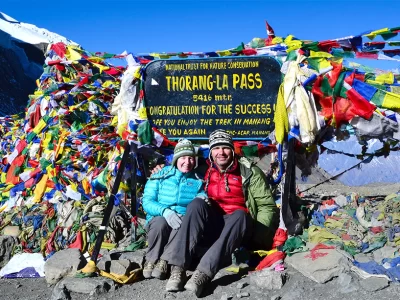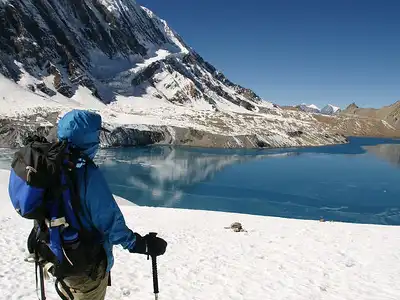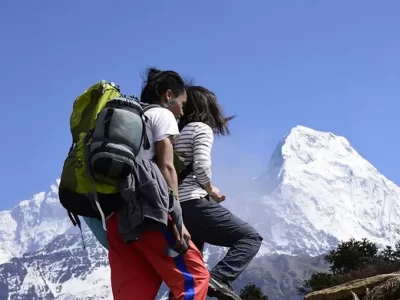Annapurna Base Camp sits at about 4,130 meters (13,549 feet), making it a challenging yet rewarding destination for trekkers. The base camp is encircled by some of the Himalayas’ most majestic peaks, including Annapurna I, Annapurna South, and Machhapuchhre (Fishtail). These towering mountains create a panoramic view that leaves visitors in awe.
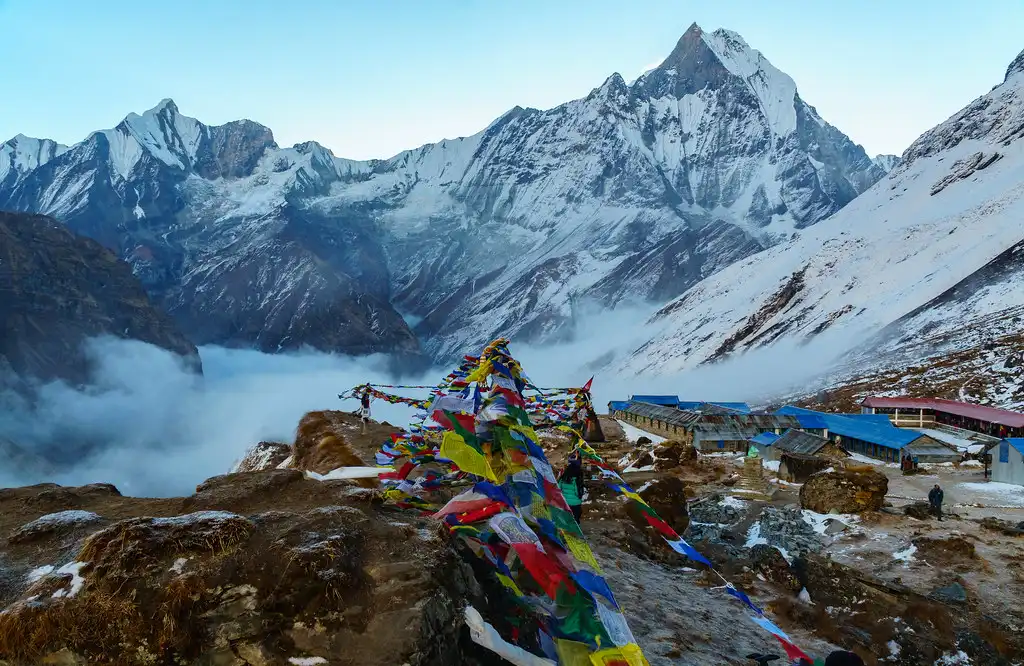
Trekking to Annapurna Base Camp means trekking through a variety of landscapes. You’ll start in lush subtropical forests, move through serene alpine meadows, and eventually reach the rugged terrain of the mountains. The region’s natural beauty unfolds every step of the way, with terraced fields, quaint villages, and cascading waterfalls adding to the experience.
Protecting the Annapurna Conservation Area: A Commitment to Nature
Annapurna Base Camp lies within the Annapurna Conservation Area, Nepal’s largest protected area, covering 7,629 square kilometers. Authorities formed this area in 1986 to conserve the diverse life forms of this zone and promote eco-friendly tourism. Establishing a conservation zone in 1986 meant protecting this area’s myriad life forms while promoting environmentally sound tourism.
The most common for this purpose is as follows: The endangered species, such as snow leopards and Himalayan tahr dots, found in the Annapurna Conservation Area include many plants and animals. Environmental conservation efforts in this region aim to maintain a natural ecosystem and provide for the cultural background of communities living there.
As you trek to Annapurna Base Camp, you’ll witness these conservation efforts firsthand. Checkpoints along the route ensure trekkers follow guidelines designed to minimize environmental impact. Adhering to these rules, you help preserve the Annapurna region’s pristine beauty for future generations.
Annapurna Base Camp Trek
Annapurna Circuit Trek
Mini Annapurna Circuit Trek
Access Routes to Annapurna Base Camp
Exploring Annapurna Base Camp (ABC) involves choosing from several trekking routes, each offering its distinct charm. The ABC Trek Route is a favorite due to its stunning landscapes and well-marked paths.
Popular Trekking Routes to Annapurna Base Camp
1. ABC Route through Ghorepani and Poon Hill
Many trekkers favor this route for its combination of cultural encounters and sweeping mountain vistas. The trek begins at Nayapul, which is easily accessible from Pokhara by road. From Nayapul, the path takes you through scenic villages like Tikhedhunga and Ulleri, eventually reaching Ghorepani.
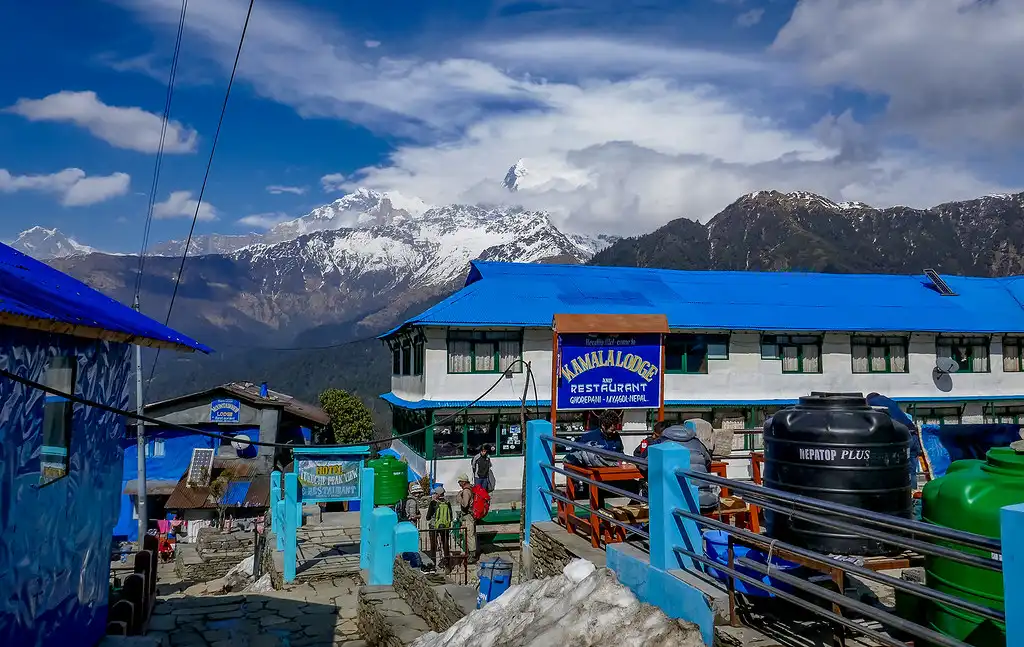
The early morning trek to Poon Hill is a highlight, offering a stunning sunrise view over the Annapurna and Dhaulagiri ranges. After soaking in the views from Poon Hill, the trek continues through rhododendron forests and quaint villages such as Tadapani and Chhomrong.
The trail steadily climbs, eventually leading you to the tranquil Machhapuchhre Base Camp. From there, it’s a short walk to Annapurna Base Camp, where breathtaking views of the surrounding peaks await.
2. ABC Route via Ghandruk
Another well-trodden path to Annapurna Base Camp begins in Ghandruk, a traditional Gurung village known for its warm hospitality and rich cultural heritage. Starting from Nayapul or Kimche, the route winds through terraced fields and dense forests, gradually ascending to Chhomrong.
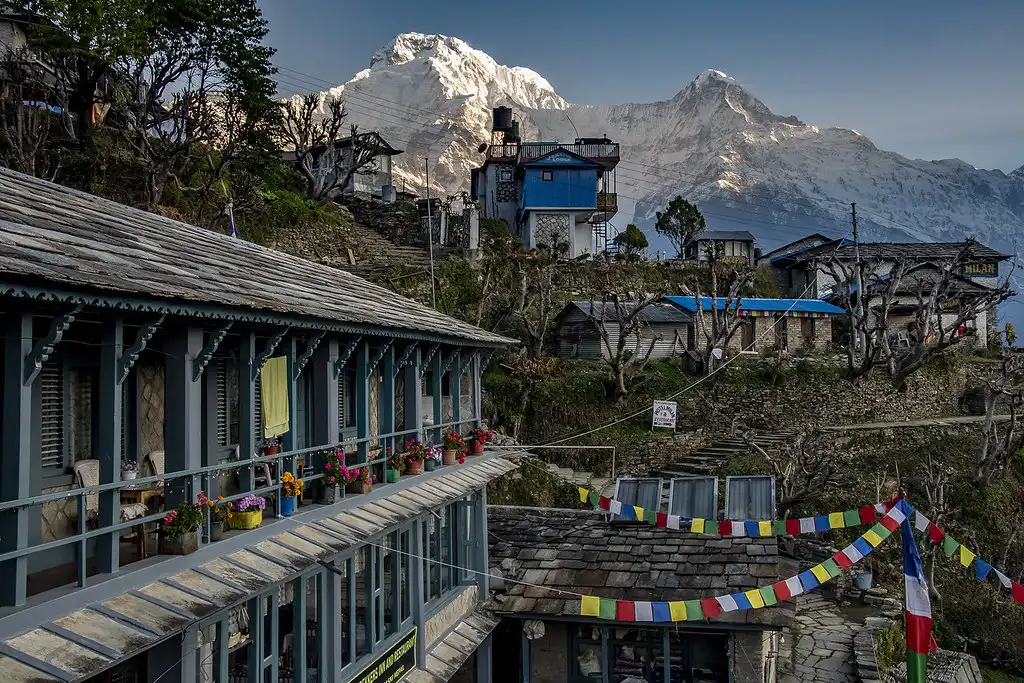
Chhomrong marks the entrance to the Annapurna Sanctuary, where the landscape shifts from lush greenery to rugged alpine terrain. From Chhomrong, the trail follows the Modi Khola River, passing through bamboo and rhododendron forests.
This route takes you to Dovan, Deurali, and eventually Machhapuchhre Base Camp, which offers spectacular views of the sacred Fishtail Mountain. The final stretch leads to Annapurna Base Camp, where trekkers can enjoy panoramic views of towering peaks.
3. ABC Route via Dhampus and Landruk
For those seeking a quieter trek, the route starting from Phedi, near Pokhara, is an excellent option. This path takes you through Dhampus, Pothana, and Landruk, offering a more gradual ascent that is less physically demanding.
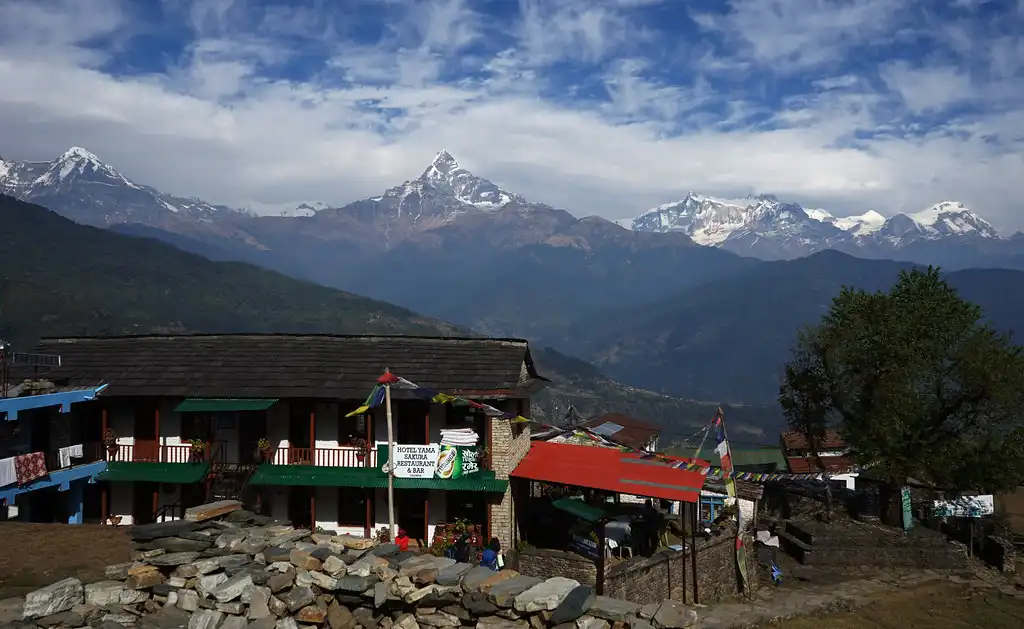
The route eventually merges with the main ABC Trek Route at Chhomrong, allowing trekkers to experience the same magnificent views and cultural encounters.
Transportation Options to Trek Starting Points
- Reaching Nayapul from Pokhara: Pokhara serves as the main base for trekkers heading to Annapurna Base Camp. From Pokhara, you can reach Nayapul, the starting point for several routes, by taxi or local bus. The drive takes 1.5 to 2 hours and offers scenic views.
- Reaching Ghandruk from Pokhara: If starting your trek from Ghandruk appeals to you, you can take a jeep or local bus from Pokhara to Kimche, a 4-5 hour trek. From Kimche, a short hike takes you to Ghandruk, the starting point for the ascent to Annapurna Base Camp.
- Reaching Phedi from Pokhara: Those opting for the route through Dhampus and Landruk can start from Phedi, a 45-minute drive from Pokhara. You can take a taxi or bus to Phedi, where you begin the hike.
Trekking Itinerary for Annapurna Base Camp
ABC trail is the ultimate voyage full of excitement across plains, combining different cultures with mountains reaching into the sky. The following paragraphs elaborate on this trek, split into several days, and contain some remarks about possible excursions or different routes.
Day 1: Arrival in Kathmandu
- Upon arrival in Kathmandu, you will be greeted and transferred to your hotel. Take some time to explore the city and prepare for the adventure ahead.
Day 2: Drive from Kathmandu to Pokhara
- Drive from Kathmandu to Pokhara, a scenic trek offering views of terraced fields and rivers.
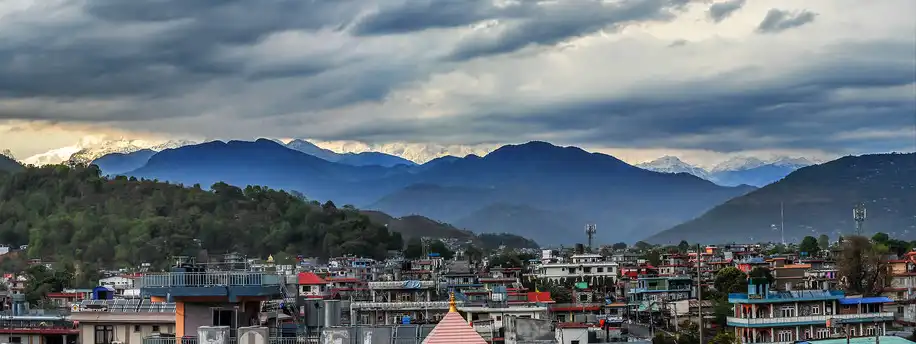
Alternatively, take a short flight to Pokhara. Spend the evening by the serene Phewa Lake.
Day 3: Drive to Nayapul and Trek to Tikhedhunga
- Start your trek with a drive from Pokhara to Nayapul. From Nayapul, trek along the banks of the Modi Khola River, passing through villages like Birethanti before reaching Tikhedhunga. This gentle start helps with acclimatization.
Day 4: Trek to Ghorepani
- Today’s trek includes a steep ascent to Ulleri, a village offering fantastic views of Annapurna South and Hiunchuli. The trek continues through rhododendron forests before arriving at Ghorepani, known for its panoramic mountain views.
Day 5: Hike to Poon Hill and Trek to Tadapani
- Make sure to begin your trek before sunrise in Poon Hill, which provides a stunning view of the Annapurna and Dhaulagiri ranges as they emerge from darkness.
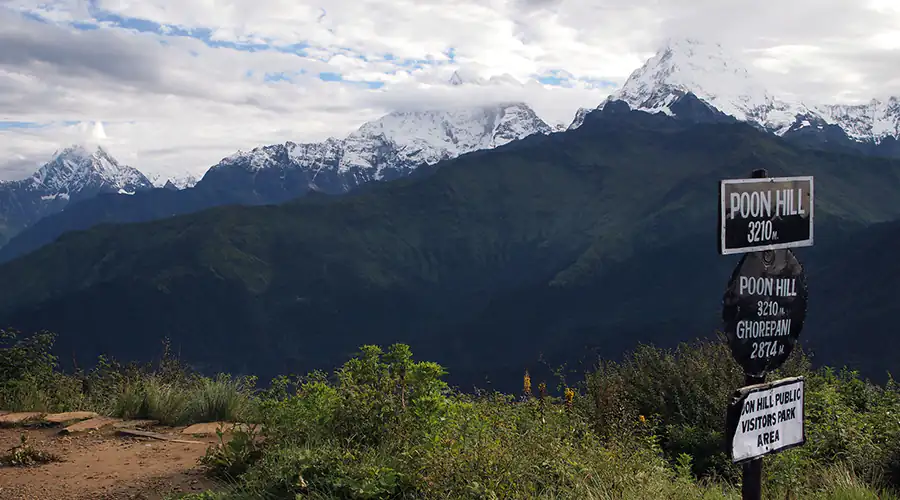
In addition, it would be wise to descend to Ghorepani and go through forests until Tadapani.
Day 6: Trek to Chhomrong
- From Tadapani, through forests and small villages, descend to Chhomrong, a Gurung central town and the gateway to the Annapurna sanctuary.
Day 7: Trek to Dovan
- From Chhomrong, the trail descends and crosses the Chhomrong River before climbing again through bamboo forests and rocky terrain to reach Dovan.
Day 8: Trek to Annapurna Base Camp via Machhapuchhre Base Camp
- This day is among the most exciting as you trek to Annapurna Base Camp.

Pass through Machhapuchhre Base Camp, which offers spectacular views of Machhapuchhre (Fishtail) and other peaks, before reaching Annapurna Base Camp at 4,130 meters.
Day 9: Trek to Bamboo
- After enjoying the views at Annapurna Base Camp, descend back to Bamboo. This route retraces your steps through the scenic valleys and forests.
Day 10: Trek to Jhinu Danda
- Today’s trek takes you to Jhinu Danda, known for its hot springs. This spot is perfect for relaxing and rejuvenating after days of trekking.
Day 11: Trek to Pothana
- From Jhinu Danda, the trail continues through beautiful landscapes and small villages, leading you to Pothana.
Day 12: Trek to Phedi and Drive to Pokhara
- On this final trekking day, descend to Phedi, where a vehicle will be waiting to take you back to Pokhara.
Day 13: Drive to Kathmandu
- Return to Kathmandu either by road or by flight. Use this time to reflect on the incredible trek you’ve completed.
Day 14: Departure
- Depart from Kathmandu, taking home unforgettable memories of the Annapurna Base Camp trek.
Side Trips and Alternative Paths
- Ghorepani to Ghandruk Route: For those seeking more cultural exposure, you can detour through Ghandruk, a traditional Gurung village. This route offers additional opportunities to experience local culture and lifestyle.
- Hot Springs at Jhinu Danda: Those who fancy trekking and are looking for a way to relax often get sidetracked at the natural hot springs in Jhinu Danda.
Tilicho Lake Trek
Mini Annapurna Circuit Trek
Ghorepani Poon Hill Trek
Elevation and Acclimatization at Annapurna Base Camp
Annapurna Base Camp (ABC) is 4,130 meters (13,549 feet) high. Reaching this altitude demands thoughtful planning and an understanding of acclimatization to prevent altitude sickness. Below is essential information about managing elevation and acclimatization on your trek to Annapurna Base Camp.
Annapurna Base Camp Elevation
Trekkers at high altitudes stand on an elevation of 4,130 meters at Annapurna Base Camp. The awe-inspiring view of the Annapurna massif featuring peaks like Annapurna I, Annapurna South, and Machhapuchhre makes the ascent worth its weight in gold.
However, when you go higher up into the mountains, there is less oxygen to breathe, which can affect your body adversely unless you acclimatize properly. Your body needs to get used to that height before starting on this trek so that you can enjoy it without endangering yourself.
Acclimatization Tips
To make sure your body adapts to the altitude at Annapurna Base Camp, follow these essential tips:
- Pace Yourself: Gradual ascent is vital in preventing altitude sickness. The ABC Trek Route typically includes rest days at strategic points like Ghorepani or Chhomrong to help acclimate.
- Hydrate Frequently: Drinking ample amounts of water helps your body acclimatize to the altitude, reducing the risk of altitude sickness. Dehydration can cause this condition.
- Avoid Alcohol and Cigarettes: Alcohol and smoking reduce your body’s ability to acclimatize, so avoid them during the trek.
- Take Planned Breaks: Schedule rest days after significant altitude gains to give your body time to adjust before continuing your trek.
- Consider Medication: Some trekkers use Acetazolamide (Diamox) to help prevent altitude sickness. Talk to a doctor before taking medicine.
Recognizing Altitude Sickness
You can get sick from the altitude if you are higher than 2,500 meters. Therefore, it is essential to know the symptoms since they might intensify as one climbs higher. Common symptoms include:
- Persistent headache
- Feeling dizzy or lightheaded
- Nausea or vomiting
- Shortness of breath
- Loss of appetite
- Trouble sleeping
Managing Altitude Sickness
If symptoms of altitude sickness develop, take the following steps immediately:
- Rest & Rehydrate: Take a break from the trek and remain at the same altitude. Drink lots of fluids, and have some rest until you feel better.
- Descend if Necessary: Moving lower as quickly as possible is essential if symptoms do not improve or worsen. Going down 300 meters can make a big difference in how you feel.
- Seek Professional Help: Medical assistance might be necessary in extreme cases. It would be best always to have an emergency evacuation plan in remote places such as Annapurna Base Camp.
Packing List and Gear Recommendations
Being prepared is vital when trekking to Annapurna Base Camp. You’ll need robust, waterproof trekking boots and a weather-resistant backpack every season. Layering is essential, so include thermal underwear, fleece layers, and a down jacket. Wear a waterproof jacket and pants, as the weather can change quickly.
Season-Specific Advice
- Spring/Autumn: These are the best times to trek. Pack light layers for day treks and warmer gear for chilly evenings.
- Winter: Wear a warmer jacket and use a sleeping bag that’s good for freezing weather.
- Monsoon: Waterproof covers for your gear and quick-dry clothing are critical due to frequent rains.
Photography and Scenic Spots
Annapurna Base Camp offers photogenic landscapes at every turn. Use the serene early morning light for dramatic photos. The Machapuchare (Fishtail) Mountain at sunrise and sunset provides a stunning backdrop for your shots.
Tips for High Altitude Photography
- Use a Polarizing Filter: This will help reduce glare from snowy surfaces and enhance the deep blues of the sky.
- Steady Your Shot: High winds can be a challenge; use a tripod for sharp images.
- Battery Care: Keep spare batteries warm and close to your body to prevent them from draining quickly in cold conditions.
Annapurna Base Camp: Safety and Cultural Etiquette
When trekking to Annapurna Base Camp, securing the correct permits is crucial. You will need two essential permits:
- Annapurna Conservation Area Permit (ACAP): This is mandatory for all trekkers entering the Annapurna region. It helps fund conservation efforts in the area.
- Trekkers’ Information Management System (TIMS) Card: This card tracks trekkers in the region, ensuring safety and security.
Safety Tips
- Altitude Sickness: Annapurna Base Camp is 4,130 meters, so that you might get altitude sickness. Acclimatize gradually, stay hydrated, and if symptoms worsen, descend immediately.
- Weather Awareness: The Annapurna Base Camp weather can change quickly. Pack layers and check forecasts regularly to avoid surprises.
- Emergency Resources: Keep local emergency contact numbers on hand, and consider hiring a guide for extra safety. The Annapurna region has limited medical facilities, so carrying a first-aid kit and any necessary medications is essential.
Local Culture and Etiquette
The ABC Trek Route passes through several villages inhabited by Gurung and Magar communities. Respect for local culture and traditions enhances your trekking experience and supports sustainable tourism. Here are a few tips:
- Greetings: A polite “Namaste” is a customary greeting.
- Monastery Etiquette: You must walk around prayer wheels and stupas in a clockwise direction when you visit monasteries along that route. First, remove your shoes before entering.
- Photography: Before taking any photos, always ask locals for their permission. Sometimes, they would appreciate it if someone said “thank you” using their language.
- Sustainability: When trekking to Annapurna Base Camp, buy things from local tea houses and stores. To reduce environmental pollution, use reusable water bottles instead of single-use plastics.
Accommodation and Food
Trekkers heading to Annapurna Base Camp will find simple but comfortable accommodations along the ABC Trek Route. Most trekkers stay in teahouses and lodges that cater to their basic needs after long trekking days. Below is a breakdown of what to expect regarding lodging and food during the trek.
Types of Accommodations: Teahouses and Lodges
Teahouses: Teahouses are the primary accommodation on the trek. These family-run lodgings offer a place to sleep and eat, creating a welcoming environment for trekkers. Rooms typically include essential bedding and shared bathrooms. You may find private rooms with attached bathrooms in busier areas, but these are rare. Facilities include:
- Simple rooms with twin beds and blankets (bring a sleeping bag for colder nights)
- Shared bathrooms with cold water, though some teahouses offer hot showers for an additional fee
- Communal dining rooms with wood stoves for warmth
- Limited electricity powered by solar panels; bring a portable charger for your devices
Lodges: Lodges along the ABC Trek Route are similar to teahouses but might offer better amenities.
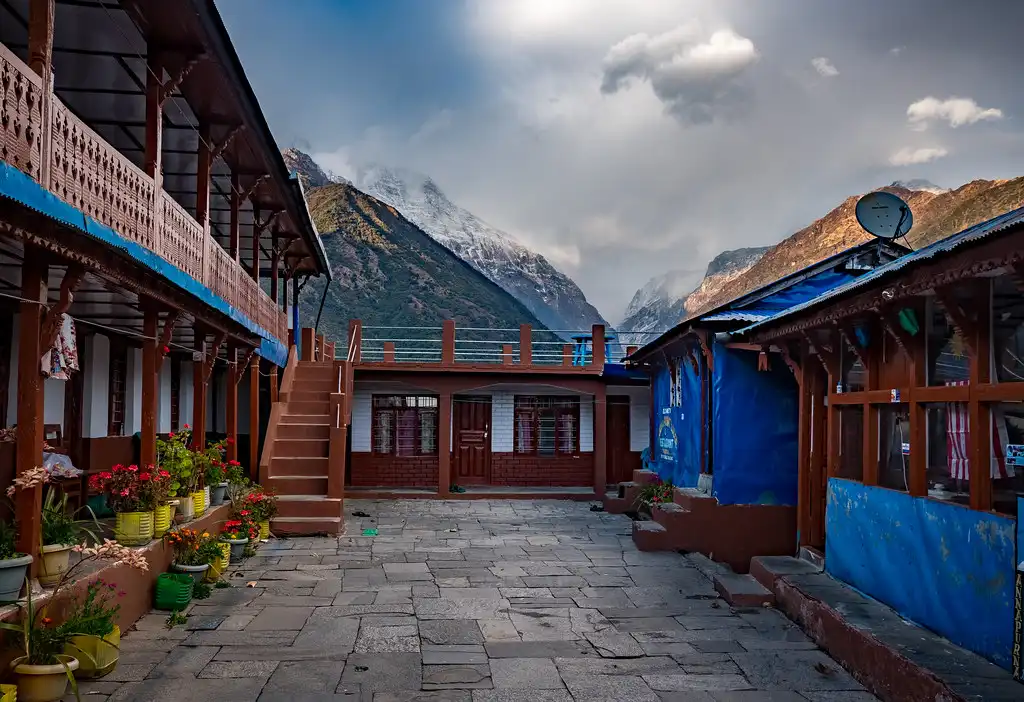
In villages like Ghorepani or Chhomrong, lodges may provide better insulation and extra comfort. Facilities include:
- Insulated rooms to keep warm in colder conditions
- Wi-Fi is available for a small fee at some lodges.
- Dining areas with a broader selection of food compared to simpler teahouses
- While accommodations remain basic, trekkers will find them comfortable enough to rest and prepare for the next day’s hike. However, it’s important to adjust expectations, as luxury is limited.
Food Options on the Trek
Trekkers will find hearty meals at teahouses and lodges designed to energize them during their trek. The menus are similar throughout the route, with options for both local Nepalese cuisine and some Western dishes.
Local Dishes
- Dal Bhat: A staple meal that includes rice, lentil soup, and vegetable curry. It is popular with trekkers for its unlimited refills and high nutritional content.
- Sherpa Stew and Thukpa: Hot soups that are perfect for warming up in the cold weather.
Western Dishes
- Pasta and Noodles: These provide a quick source of carbohydrates to fuel long trekking days.
- Pancakes and Eggs are common breakfast choices, usually served with tea or coffee.
Conservation Efforts in the Annapurna Region
The Annapurna Conservation Area Project (ACAP) actively preserves the Annapurna region’s natural and cultural heritage by protecting over 7,600 square kilometers of biodiversity and cultural richness.
Environmental Conservation
- Biodiversity Protection: The Annapurna region has many plants and animals, some very rare. ACAP actively works to protect these species through strict guidelines that prevent hunting and habitat destruction.
- Waste Management: Trekkers should care for the environment and not leave any trash. ACAP has made rules to help keep the area clean. For instance, many teahouses no longer sell bottled water and instead offer filtered water to reduce plastic waste.
- Sustainable Tourism: ACAP promotes sustainable tourism by encouraging eco-friendly practices among trekkers and local communities. For example, many teahouses use solar energy for heating and lighting, and some grow their vegetables to provide food for trekkers.
Cultural Conservation
The Annapurna region is culturally diverse and home to the Gurung, Magar, and Thakali communities. ACAP’s initiatives also focus on preserving these communities’ traditional customs and ways of life.
- Cultural Preservation: ACAP supports local festivals, traditional handicrafts, and cultural practices to ensure the region’s heritage thrives for future generations.
- Community-Based Tourism: ACAP’s approach ensures that local communities benefit directly from tourism. Many teahouses and lodges are family-run businesses, and ACAP encourages trekkers to hire local guides and porters, providing economic support to the region.
Conclusion
Trekking to Annapurna Base Camp combines captivating landscapes, cultural encounters, and satisfying challenges. Standing at 4,130 meters, you can enjoy panoramic views of towering peaks like Annapurna I and Machhapuchhre.
The diverse scenery unfolds as you trek along the ABC Trek Route, offering countless chances to capture beautiful moments in Annapurna Base Camp photos.
Highlights Recap
- Stunning Views: Enjoy breathtaking scenery from Poon Hill and Annapurna Base Camp. Capture stunning photos of snow-capped peaks and dramatic valleys.
- Rich Culture: Walk through traditional Gurung and Magar villages, experiencing warm hospitality and a glimpse into local life.
- Diverse Terrain: Trek through forests, terraced fields, and alpine meadows, all within the Annapurna Conservation Area.
Personal Tips
- Prepare for Weather: Annapurna Base Camp weather can change rapidly. Pack layers and plan your trek during spring or autumn for the best conditions.
- Acclimatize: Ascend slowly and give your body time to adapt. Proper acclimatization helps prevent altitude sickness.
- Capture Stunning Moments: Bring a reliable camera and take advantage of golden hours during your trek to get the best photos.

